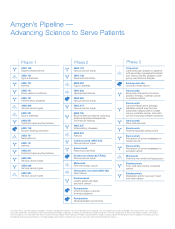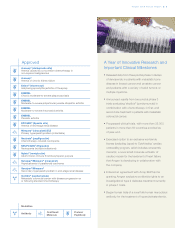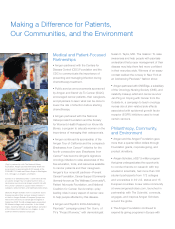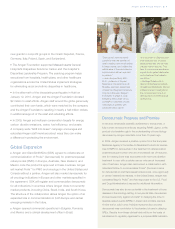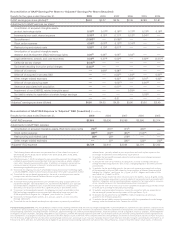Amgen 2009 Annual Report Download - page 16
Download and view the complete annual report
Please find page 16 of the 2009 Amgen annual report below. You can navigate through the pages in the report by either clicking on the pages listed below, or by using the keyword search tool below to find specific information within the annual report.patents, or a reduction in the price we receive from selling our products. For example, we are facing increasing
competition from biosimilars in the European Union (“EU”), which has an established regulatory pathway for
biosimilars. In addition, lawmakers in the United States have proposed bills to create a regulatory pathway for
the abbreviated approval of biosimilars and several companies have recently announced plans to pursue
development of biosimilars in the United States. Further, the development of new treatment options or standards
of care may require less use of our products, particularly in supportive cancer care, or limit the utility and
application of ongoing clinical trials for our product candidates.
In addition to challenges presented by competition, our existing products and product candidates are also
subject to increasing regulatory compliance requirements which can be imposed as a condition of approval or af-
ter a product has been approved. This is increasingly true of new therapies with novel mechanisms of action.
While these therapies may offer important benefits and/or better treatment alternatives, they may also involve a
relatively new or higher level of scientific complexity and, therefore, generate increased safety concerns. For ex-
ample, as a condition of approval or due to safety concerns after the product has been approved, we may be
required to perform additional clinical trials or studies, such as observational epidemiological studies. Such trials
or studies are called PMCs or PMRs. We currently have PMCs or PMRs for some of our marketed products. In
addition, we may be required to implement a REMS for a product to ensure that the benefits of the drug outweigh
the risks. This requirement, too, may be imposed as a condition of approval or after a product has been on the
market. A REMS may include a medication guide or a patient package insert, a healthcare provider communica-
tion plan or other elements the FDA deems are necessary to assure safe use of the product. While the elements of
a REMS may vary, all REMS are required to have a timetable for assessments.
ESAs
Aranesp®is our registered trademark for one of our ESAs, a protein that stimulates red blood cell pro-
duction. Red blood cells transport oxygen to all cells of the body. Without adequate amounts of erythropoietin,
the red blood cell count is reduced. A deficient red blood cell count can result in anemia, a condition where in-
sufficient oxygen is delivered to the body’s organs and tissues. Anemia can be associated with chronic renal
failure (“CRF”), both in patients on dialysis and not on dialysis. Anemia can also result from chemotherapy
treatments for patients with non-myeloid malignancies.
EPOGEN®is our other ESA and is our registered trademark for our recombinant human erythropoietin prod-
uct, a protein that stimulates red blood cell production. A reduced red blood cell count can result in anemia (see
“— Aranesp®(darbepoetin alfa)”). Individuals with CRF suffer from anemia because they do not produce suffi-
cient amounts of erythropoietin, which is normally produced in healthy kidneys.
Our ESA products have and will continue to face challenges. For example, based on adverse safety results
observed beginning in late 2006 in various ESA studies, performed by us and others, that explored the use of
ESAs in settings different from those outlined in the FDA approved label, the product labeling of our ESA prod-
ucts has been updated several times to reflect these safety concerns in the United States and the EU, including,
most recently, label updates in the United States in August 2008 and in December 2009 to reflect certain results
of our TREAT study, as discussed below. In addition, due in part to certain of these developments, reimburse-
ment of our ESA products in the United States was also revised resulting in changes in the way ESAs are used in
clinical practice, including by decreasing the number of treated patients, average dose and duration of ESA ther-
apy. Certain of these developments have had a material adverse impact on sales of our ESA products, in
particular Aranesp®sales in the U.S. supportive cancer care setting.
Further, we believe that certain of the following recent and pending developments could have a material ad-
verse impact on the future sales of Aranesp®and EPOGEN®:
• On February 16, 2010, Amgen and Centocor Ortho Biotech Products, L.P. (“Centocor Ortho Biotech
Products”), a subsidiary of Johnson & Johnson (“J&J”), announced that the FDA approved a REMS for
ESAs which includes Aranesp®, EPOGEN®and Procrit®(Epoetin alfa). The FDA has determined that a
REMS is necessary for ESAs to ensure the benefits of these drugs outweigh the risks of shortened overall
survival (“OS”) and/or increased tumor progression or recurrence as identified in clinical studies in
4


